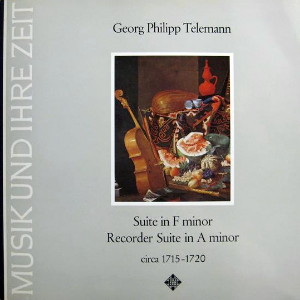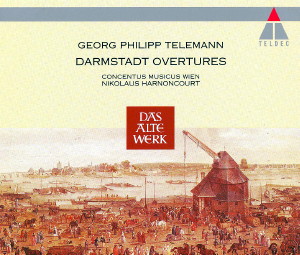 |
1 LP -
SAWT 9507-A - (p) 1967
|
 |
| 2 CD -
4509-93772-2 - (c) 1994 |
|
| Georg Philipp
Telemann (1681-1767) |
|
|
|
|
|
|
|
| Suite in F minor for two
violins, viola, two recorders (in the
Chaconne) and basso continuo |
|
22' 59" |
|
| - Ouverture |
5' 09" |
|
A1 |
- Menuet
1 & 2
|
2' 28" |
|
A2 |
| - Rondeau |
0' 56" |
|
A3 |
| - Sarabande |
2' 12" |
|
A4 |
| - Passepied |
1' 07" |
|
A5 |
| - Plainte |
4' 01" |
|
A6 |
- Allemande
|
1' 49" |
|
A7 |
- Chaconne
|
4' 05" |
|
A8 |
| - Gigue |
1' 12" |
|
A9 |
Suite in A minor for
recorder, two violins, viola and basso
continuo
|
|
28' 59" |
|
- Ouverture
|
7' 18"
|
|
B1 |
| - Les Plaisirs |
3' 12" |
|
B2 |
| - Air à l'Italien |
6' 27" |
|
B3 |
| - Menuet 1 and 2 |
4' 21" |
|
B4 |
- Rèjouissance
|
2' 40" |
|
B5 |
| - Passepied 1 & 2 |
2' 01" |
|
B6 |
| - Polonaise |
3' 00" |
|
B7 |
|
|
|
|
Frans Brüggen,
Recorder
|
|
Jeanette van
Wingerden, Recorder (F
minor Suite)
|
|
|
|
CONCENTUS
MUSICUS, Vienna (with original instruments)
|
|
-
Alice Harnoncourt, 1st Violin, solo
violin
|
-
Nikolaus Harnoncourt, Tenor
fiedel - alto line |
|
| -
Peter Schoberwalter, 1st Violin |
-
Hermann Höbarth, Violoncello |
|
| -
Kurt Theiner, 1st Violin |
-
Eduard Hruza, Violone -
double-bass |
|
| -
Walter Pfeiffer, 2nd Violin |
-
Herbert Tachezi, Harpsichord |
|
| -
Josef de Sordi, 2nd Violin |
|
|
|
|
Nikolaus
Harnoncourt, Conductor (A
minor Suite)
|
|
Frans Brüggen,
Conductor (F minor Suite)
|
|
|
Luogo
e data di registrazione
|
-
Casino Zögernitz,
Vienna (Austria) - 28 marzo / 1 aprile
1966 - (Suite in F minor)
- Casino Zögernitz,
Vienna (Austria) - 14-15
ottobre 1966 - (Suite in A
minor) |
|
Registrazione
live / studio
|
| studio |
Producer
/ Engineer
|
Wolf
Erichson
|
Prima Edizione CD
|
Teldec
"Das Alte Werk" - 4509-93772-2 - (2 cd)
- 73' 15" + 75' 22" - (c) 1994 - ADD
|
Prima
Edizione LP
|
Telefunken "Das
Alte Werk" - SAWT 9507-A - (1 lp) - 51'
58"
- (p) 1967
|
|
|
Notes
|
Of the roughly two
hundred Suites and Ouvertures for
orchestra, which Telemann, according
to his own words, composed up to 1718,
a considerable number date already
from the time that he was
kapellmeister in Sorau. It is not yet
established which of the roughly 120
works still preserved belong to this
groups. On the other hand, at least a
certain proportion of those Suites
which have been handed down in
manuscript from the Darmstadt court
music was in all probability produced
actually in and for Frankfurt and for
Darmstadt, i. e. between 1712 and
1721. Evidence for this lies in the
mostly quite modest instrumentation of
these Suites for four-part string
orchestra, indicating consideration
for local practical conditions: the
similarly unassuming scoring of most
of the suites and symphonies of the
court kapellmeister at Darmstadt,
Telemann's friend Christoph Graupner,
clearly indicates such conditions.
Both Suites in the present recording
in any case beong, according to their
circumstances of preservation and
their scoring, and presumably also
according to their period of origin,
to this group of works from Frankfurt
and Darmstadt. Both are formal
"Frebch" suites of the pattern which
the instrumental music of the court of
Veersailles had passed on to the
courts and towns of Europe, which had
appreciated the heritage; both change
this pattern by the richness of
incention and the formal and technical
elegance which are already so
characteristicas of the young
Telemann.
The F minor Suite includes no fewer
than nine movenets, deliberately
alternating between traditional fance
forms and fashionable "character
pieces", slow and fast tempi, serious
and gay ranges of expression. The Ouverture
follows the traditional pattern of a
slow introduction in dotted rhythm and
a fast fugato with an abbreviated
repetition of the introduction, but it
link the two sections together by
continuing, and even intensifying, the
basic dotted rhuthm and the
upward-thrusting chromatic melodie
line of the fugato. Through this the
movement achieves a peculiarly nervous
intensity and a restlessly glittering
tone-coloration, which considerably
extends the traditional sphere of
expression of a French overture -
clearly, already, in the direction of
an individual expressive "character".
The Minuet, too, clearly links
courtly convention and individual
expression: in type it belongs wholly
to the tradition of the ceremonial
French minuet, but the gracefully
regular bar-grouping and the elegant
cantabile ot the upper melodie line
are a mixture of an elegiac element
and of harmonic colourfulness,
carefully aiming over and above mere
convention, without thereby offending
against the "bon goût" of society.
This little elegy is followed by an
extremely gay Rondeau of the
rhythmic type of a bourrée,
thematically strikingly reminiscent of
Rameau's famous Tambourin
(published in 1724). In strong
contrast to this playfully fashionable
movement, there follows a serious
"character piece", a Sarabande,
which unites extended melodie arches,
almost consistently falling, and
richly chromatic harmony, with a
subdued pathos.
A relaxed frivolity again answers this
carnest intensity in a quick Passepied
with shortbreathed rhythmic
hesitations, syncopations and suddenly
contrasting little sighing motifs. The
following Plainte is a serious
"character piece" that, not only by
its title but equally by its moving
bass and the lyrical periods of its
nobly elegiac melody, recalls Rameau,
whose Les tendres plaintes
from Pièces de clavecin of
1724 it however surpasses in its
melodie intensity and in its
harmonies, full of surprises and
steeped in emotion.
Harmonic intensity and the technique
of surprises, especially at cadences,
also characterise the Allemande,
which like the Minuet goes
beyond this to give to the traditional
dance-character individuality and a
slightly eleciac quality, without
sacrificing the elegance of the
springy rhythm of the Allemande.
The far-reaching Chaconne,
free in form but rounded off with a
large da capo, holds two surprises in
store: fintly the introduction of two
prominent recorders, used for the most
part in concertante style, and giving
the movement, from the tonal point of
view also, a special colour; and
secondly tha fact that the Chaconne
is not, as one would expect according
to tradition, the final movement of
the work. Rather it is followed, as a
playful and capricious relaxation
after the typically ceremonial
solemnity of the Chaconne, by
a brisk Gigue, which with its
gay syncopations and surprising
extension of phrases brings a masterly
and witty "disorder" to the
symmetrical phrases of a typical
gigue, and thus brings the whole suite
to an unexpectedly light-hearted and
conspicously piquant end.
The A minor Suite too is a work in the
"French taste", but which in its
individualising of the traditional
dance forms follows quite different
paths, linking elements of the French
suite and of the Italian concerto by
the inclusion of a concertino
recorder. It thereby, in the Air à
l'Italien and in the Polonaise,
as also in the stress on the "réunion
des goûts", aims at that blending of
national musical styles which so
occupied musical aesthetics between
the baroque and classical periods, and
about the middle of the century was
theoretically proclaimed the specific
task of German music, and which
Telemann, that musical man of the
world, democrat and cosmopolitan, put
into practice as no other composer had
done. Thus the Ouverture
indeed begins with the usual slow
introduction in dotted rhythm, but
enlarges the Allegro to an almost
"Italian" concerto movement, in which
the tutti sections, fugal in complete
accord with the French tradition,
alternate with three long and
virtuosic recorder solos. Then follow,
as if in explanation of what the Ouverture
had announced, on the one hand
"French" dance movements, in which the
recorder however as a solo instrument
dominates the respective Trios, and on
the other hand "Italian" concerto
movements, in which tutti and solo
alternate as in a concerto, but
embedded in dance movement forms. A
differentiation of the characters of
the movements conforms eventually to
the intentwining at different levels
of their types and forms: this makes
of the work an example, unusual even
for Telemann, of subtle skill and
sovereign synthesis of style within
the framework of a seemingly
unpretentious and entertaining form Les
Plaisirs in the first dance
movement of this style, described
above, very fast and capricious, with
a virtuoso flute solo for Trio. The Air
à l'Italien is an authentic slow
concerto movement which emerges into a
longer type of pathetic andante
movement; yet by its surprising
allegro solo it capriciously gives
freedom to this form, which at the
same time approaches that of a
suite-movement as a result of the
ensuing repetition of the main
section.
The Minuet is another courtly
galant dance movement, with a Trio (Minuet
2) that is laid out as a solo
variation of the main section, i. e.
as an authentic French "double". The
Réjouissance changes the
contrast of tutti with solo to an
alternation of snippers of a
capriccious brevity within the
framework of a ternary form like that
of a dance movement. The Passepied
is again a dance movement with a solo
Trio (Passepied 2), which in
its courtly, elegant inflections is
strongly reminiscent of the Menuet.
The last movement, a concertante Polonaise
in a slightly "exotically" written A
minor with free leading-notes, clearly
shows that Telemann had, during his
time as kapellmeister at Sorau,
thoroughly studied "Polish and
Bohemian music in their true barabaric
beauty", of which he speaks with such
enthusiasm in his 1740 autobiography,
and which he afterwards did not
forget. In the refinement of this
"exotic" quality, and above all in the
rhythmic elegance of the movement,
there appears however, at the same
time, the basic of the whole work,
once again condensed and highlighted:
the uniting of the most varied styles
and forms of late baroque music, in
the shape of an ingenious
entertainment - the "réunion des
goûts" which could please every
musical taste without sacrificiag its
own.
|
|
Nikolaus
Harnoncourt (1929-2016)
|

|

|
|